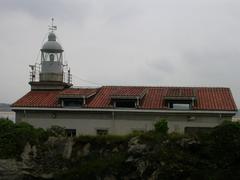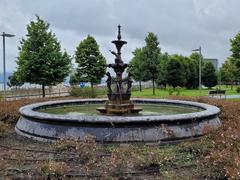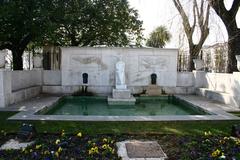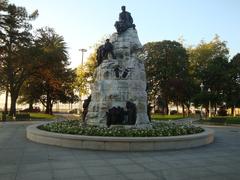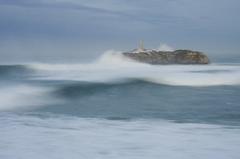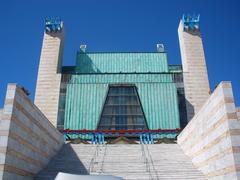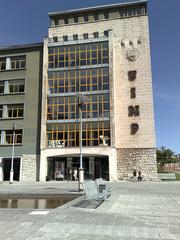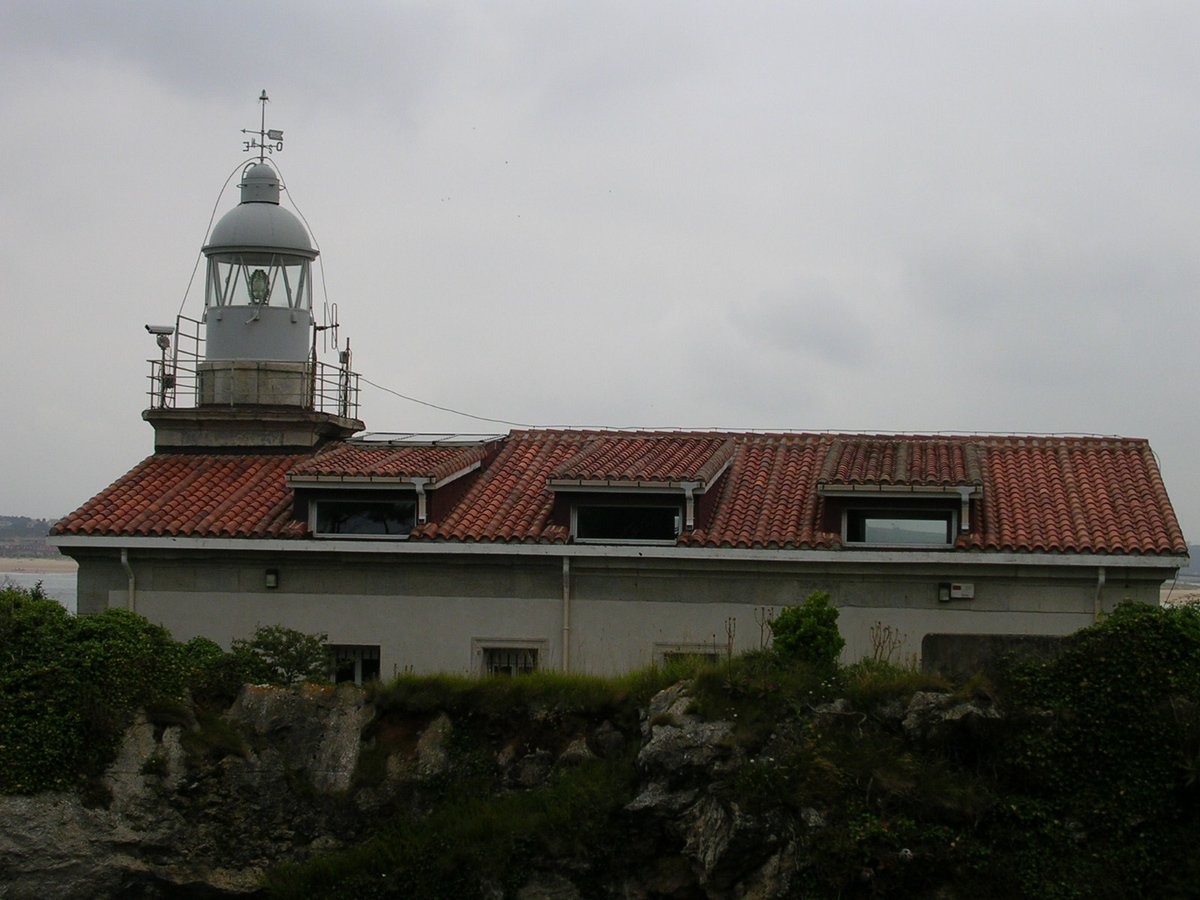
Comprehensive Guide to Visiting Faro de la Punta de la Cerda, Santander, Spain
Publication Date: 01/08/2024
Introduction to Faro de la Punta de la Cerda
Faro de la Punta de la Cerda, also known as Faro de la Cerda or Faro de la Argolla, is a prominent historical landmark situated at the entrance of Bahía de Santander, Cantabria, Spain. Inaugurated in 1870, this lighthouse has served as a crucial guide for maritime navigation and a safeguard for vessels approaching the bay. Its strategic position on the Punta de la Magdalena peninsula highlights its historical importance in maritime safety, particularly for the unloading of hazardous materials like dynamite and gunpowder (El Confidencial). Over the years, the lighthouse has evolved not only as a beacon of navigation but also as a cultural and educational site, now housing the ‘Aula del Mar,’ an initiative by the Port Authority of Santander in collaboration with the University of Cantabria and the International University Menéndez Pelayo. This transformation underscores the lighthouse’s enduring legacy and its role in promoting marine science and environmental awareness (El Confidencial).
Table of Contents
- Introduction
- History of Faro de la Punta de la Cerda
- Visitor Information
- Historical Significance
- Preservation Efforts
- Cultural Impact
- Visitor Experience
- Conservation Efforts
- FAQ
- Conclusion
- Call to Action
Exploring Faro de la Punta de la Cerda: History, Visitor Tips, and Cultural Significance
Introduction
Faro de la Punta de la Cerda stands as a beacon of history and culture at the entrance of Bahía de Santander. This iconic lighthouse has guided countless vessels safely through the bay and remains a cherished landmark in the region. In this article, we will delve into its rich history, architectural features, operational changes, and cultural impact. We’ll also provide essential visitor information, including tickets, visiting hours, and nearby attractions.
History of Faro de la Punta de la Cerda
Construction and Early Purpose
Located at the entrance of the Bahía de Santander, Faro de la Punta de la Cerda was constructed to facilitate the unloading of hazardous materials at a nearby mooring without the need to enter the bay. This lighthouse played a crucial role in maritime safety and logistics. Its strategic location on the Punta de la Magdalena peninsula made it an ideal spot for such activities (El Confidencial).
Architectural Features
The lighthouse’s design reflects the architectural trends of its time. It features a robust structure capable of withstanding the harsh maritime conditions of the Cantabrian coast. The tower, built with durable materials, stands as a testament to the engineering prowess of the era. The surrounding area, characterized by its idyllic setting near the magnificent Palacio de la Magdalena, adds to the lighthouse’s historical and aesthetic value (El Confidencial).
Operational History
Since its inception, Faro de la Punta de la Cerda has undergone various operational changes. Initially, it served as a critical point for maritime navigation and safety. Over the years, advancements in technology and changes in maritime routes have influenced its operational dynamics. Despite these changes, the lighthouse has remained a significant landmark in Santander, continuing to guide vessels and ensuring safe passage through the bay (El Confidencial).
Visitor Information
Visiting Hours and Tickets
Faro de la Punta de la Cerda is open to visitors year-round. However, the best times to visit are during the spring and summer months when the weather is pleasant. Specific visiting hours and ticket prices can be found on the official website of the lighthouse or by contacting the local tourist information center.
Travel Tips
- Accessibility: The lighthouse is accessible by car, bike, or foot. There are also public transportation options available from downtown Santander.
- Nearby Attractions: Don’t miss the nearby Palacio de la Magdalena and the beautiful Magdalena Peninsula, which offer additional historical and scenic experiences.
- Guided Tours: Guided tours are available and highly recommended for those interested in the detailed history and architectural features of the lighthouse.
Historical Significance
The historical significance of Faro de la Punta de la Cerda extends beyond its functional role. It stands as a symbol of the maritime heritage of Santander and the broader Cantabrian region. The lighthouse has witnessed numerous historical events and has been a silent observer of the evolving maritime landscape. Its presence is a reminder of the region’s rich nautical history and its ongoing connection to the sea (El Confidencial).
Preservation Efforts
Efforts to preserve Faro de la Punta de la Cerda have been ongoing, recognizing its historical and cultural importance. Restoration projects have aimed to maintain its structural integrity and historical authenticity. These efforts ensure that the lighthouse remains a prominent feature of Santander’s coastal landscape, attracting visitors and maritime enthusiasts alike (El Confidencial).
Cultural Impact
The cultural impact of Faro de la Punta de la Cerda is evident in its integration into local traditions and narratives. It has inspired various artistic and literary works, reflecting its iconic status in the region. The lighthouse is not just a navigational aid but also a cultural landmark that embodies the spirit of Santander and its maritime heritage (El Confidencial).
Visitor Experience
Today, Faro de la Punta de la Cerda is a popular tourist destination, offering visitors a glimpse into the maritime history of Santander. The surrounding area, with its scenic beauty and historical landmarks, provides a perfect backdrop for exploring the lighthouse. Visitors can enjoy panoramic views of the bay and the city, making it a memorable experience for all who visit (El Confidencial).
FAQ
Q: What are the visiting hours for Faro de la Punta de la Cerda?
A: The lighthouse is open year-round with specific visiting hours available on the official website or by contacting the local tourist information center.
Q: How much are the tickets to visit the lighthouse?
A: Ticket prices can vary, and it is best to check the official website or local tourist information center for the most accurate information.
Q: Are guided tours available?
A: Yes, guided tours are available and recommended for those interested in learning more about the lighthouse’s history and architecture.
Conclusion
Faro de la Punta de la Cerda stands as a beacon of history, culture, and maritime heritage. Its construction, operational history, and cultural significance make it a vital part of Santander’s coastal landscape. Preservation efforts ensure that this iconic lighthouse continues to inspire and guide future generations, maintaining its place as a cherished landmark in the region (El Confidencial).
Call to Action
For more information and updates on Faro de la Punta de la Cerda, download our mobile app Audiala, check out other related posts on our website, or follow us on social media. Plan your visit today and experience the rich maritime history of Santander!
Essential Visitor Tips and Top Attractions Near Faro de la Punta de la Cerda, Santander
Introduction
Discover the charm and historical significance of Faro de la Punta de la Cerda, a picturesque lighthouse located on the stunning Península de la Magdalena in Santander, Cantabria. This guide provides essential visitor tips, nearby attractions, and practical information to help you make the most of your visit. Whether you’re interested in maritime history, photography, or simply enjoying the scenic views, Faro de la Punta de la Cerda offers something for everyone.
Visitor Tips
Best Time to Visit
The Faro de la Punta de la Cerda is a year-round destination, but the best time to visit is during the late spring to early autumn months (May to September). During this period, the weather is generally pleasant, with temperatures ranging from 15°C to 25°C, making it ideal for outdoor activities and sightseeing. Be mindful that the area can be windy, especially in the autumn and winter months, so dress accordingly.
Accessibility
The lighthouse is located on the picturesque Península de la Magdalena, which is easily accessible by car, public transport, or on foot. The address is Calle Familia Real, 1, Santander, Cantabria. For those driving, there is ample parking available near the entrance of the peninsula. Public buses also service the area, with stops close to the entrance of the peninsula.
Guided Tours and Educational Programs
The Faro de la Punta de la Cerda is not just a lighthouse but also houses the “Aula del Mar,” an educational project run by the Port Authority of Santander in collaboration with the University of Cantabria and the Universidad Internacional Menéndez Pelayo. Visitors can participate in guided tours and educational programs that provide insights into maritime navigation and the local marine ecosystem. It is advisable to check the schedule and book in advance, especially during peak tourist seasons. More information can be found on the Port Authority’s website.
Photography Tips
The lighthouse offers stunning views of the Bay of Santander and the surrounding coastline. For the best photographs, visit during the golden hours—early morning or late afternoon—when the light is soft and the colors are vibrant. The lighthouse itself, with its white tower and scenic backdrop, makes for a perfect subject. Don’t forget to capture the panoramic views from the nearby cliffs and the picturesque paths that lead to the lighthouse.
Safety Precautions
While the area around the lighthouse is generally safe, it is essential to stay on marked paths and avoid venturing too close to the cliff edges, especially during windy conditions. The rocks can be slippery, so wear appropriate footwear. Additionally, if you are visiting with children, keep a close watch on them, particularly near the water and cliffs.
Nearby Attractions
Palacio de la Magdalena
Located just a short walk from the Faro de la Punta de la Cerda, the Palacio de la Magdalena is one of Santander’s most iconic landmarks. This grand palace, built between 1908 and 1912, served as a summer residence for the Spanish royal family. Today, it is open to the public and offers guided tours that showcase its elegant interiors and historical significance. The palace is surrounded by beautiful gardens and offers stunning views of the bay. More details can be found on the official website.
Playa de la Magdalena and Playa del Bikini
Adjacent to the peninsula are two popular beaches: Playa de la Magdalena and Playa del Bikini. These sandy shores are perfect for a relaxing day by the sea. Playa de la Magdalena is ideal for families, with calm waters and plenty of amenities, while Playa del Bikini is a favorite among younger crowds and offers a more laid-back atmosphere. Both beaches provide excellent opportunities for swimming, sunbathing, and beach sports.
Minizoo de La Magdalena
For a family-friendly activity, visit the Minizoo de La Magdalena, located within the grounds of the Palacio de la Magdalena. This small zoo is home to a variety of marine animals, including seals, sea lions, and penguins. The feeding times are particularly popular and provide an educational experience for children and adults alike. The zoo is open daily, and entry is free. More information can be found on the Santander tourism website.
Faro de Cabo Mayor
A short drive or a scenic walk from the Faro de la Punta de la Cerda is the Faro de Cabo Mayor. This lighthouse, situated on a cliff, offers breathtaking views of the rugged coastline and the Cantabrian Sea. The area around the lighthouse features several walking trails and a small museum that provides insights into the history of maritime navigation in the region. The lighthouse is a must-visit for those interested in photography and nature. More details are available on the Cantabria tourism website.
Isla de Mouro
Visible from the Faro de la Punta de la Cerda, the Isla de Mouro is another notable landmark. Although the island itself is not accessible to the public, it is a popular subject for photographers and can be admired from various vantage points along the coast. The island’s lighthouse, which has withstood the harsh maritime conditions for over a century, adds to the dramatic scenery. Boat tours around the island are available and offer a unique perspective of the lighthouse and the surrounding waters.
Paseo Marítimo and Los Raqueros
For a leisurely stroll, head to the Paseo Marítimo, a scenic promenade that runs along the waterfront of Santander. Along the way, you will encounter the famous sculpture group “Los Raqueros,” which depicts children diving into the bay. This area is perfect for a relaxing walk, with plenty of cafes and restaurants where you can enjoy local cuisine while taking in the views of the bay.
Catedral de Santander
A visit to Santander would not be complete without exploring its historical center, where the Catedral de Santander stands. This Gothic-style cathedral, dating back to the 12th century, is a significant religious and architectural landmark. The cathedral’s interior features beautiful stained glass windows and a crypt that houses the remains of early Christian martyrs. Guided tours are available, providing insights into the cathedral’s history and its role in the city’s cultural heritage. More information can be found on the Santander tourism website.
Playa del Sardinero
One of Santander’s most famous beaches, Playa del Sardinero, is located a short distance from the Faro de la Punta de la Cerda. This expansive beach is known for its fine golden sand and excellent facilities, making it a favorite among locals and tourists alike. The beach is divided into two sections, Primera Playa and Segunda Playa, both offering ample space for sunbathing, swimming, and beach sports. The surrounding area is dotted with elegant hotels, restaurants, and shops, providing everything you need for a perfect beach day.
Practical Information
Opening Hours
The Península de la Magdalena, where the Faro de la Punta de la Cerda is located, is open to the public from 8:00 AM to 10:00 PM daily. The lighthouse itself and the Aula del Mar have specific visiting hours, which can vary, so it is advisable to check in advance.
Admission Fees
There is no admission fee to enter the Península de la Magdalena or to visit the Faro de la Punta de la Cerda. However, some attractions within the peninsula, such as the Palacio de la Magdalena and the Minizoo, may have separate entry fees.
Facilities
The peninsula is well-equipped with facilities, including restrooms, picnic areas, and cafes. There are also several information points where visitors can obtain maps and brochures about the area.
Transportation
For those relying on public transport, several bus lines service the area, with stops near the entrance to the Península de la Magdalena. Taxis and ride-sharing services are also readily available in Santander.
FAQ
Q: What are the visiting hours for Faro de la Punta de la Cerda?
A: The Península de la Magdalena is open daily from 8:00 AM to 10:00 PM. The lighthouse and the Aula del Mar have specific visiting hours, so it’s best to check in advance.
Q: Is there an admission fee for Faro de la Punta de la Cerda?
A: There is no admission fee to enter the Península de la Magdalena or visit the Faro de la Punta de la Cerda. However, some attractions within the peninsula may have separate entry fees.
Q: What are the best nearby attractions to Faro de la Punta de la Cerda?
A: Nearby attractions include Palacio de la Magdalena, Playa de la Magdalena, Playa del Bikini, Minizoo de La Magdalena, Faro de Cabo Mayor, Isla de Mouro, Paseo Marítimo and Los Raqueros, Catedral de Santander, and Playa del Sardinero.
Stay Up to Date
For the latest updates and more information on visiting Faro de la Punta de la Cerda and other attractions in Santander, download the mobile app Audiala, check out our related posts, or follow us on social media.
Summary and Conclusion
The Faro de la Punta de la Cerda stands as a testament to the rich maritime heritage and historical significance of Santander, Cantabria. From its initial role in ensuring the safe unloading of hazardous materials to its current status as a cultural and educational landmark, the lighthouse has continually adapted to the changing needs of its time. Preservation efforts have ensured that its architectural integrity and historical authenticity are maintained, allowing future generations to appreciate its significance. The ‘Aula del Mar’ initiative further enriches the visitor experience by offering educational programs that promote marine science and environmental stewardship. Nearby attractions such as the Palacio de la Magdalena, Playa de la Magdalena, and the Minizoo de La Magdalena offer additional opportunities for exploration and enjoyment, making a visit to the Faro de la Punta de la Cerda a comprehensive and memorable experience. Whether you are a history enthusiast, a nature lover, or simply looking for a scenic spot to explore, this lighthouse offers a unique glimpse into the maritime history and cultural landscape of Santander (El Confidencial).
References
- El Confidencial, 2021, Anonymous [El Confidencial](https://www.elconfidencial.com/v
